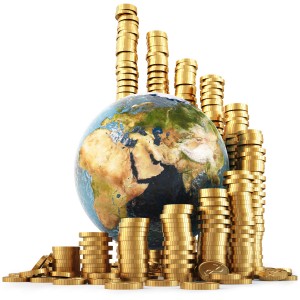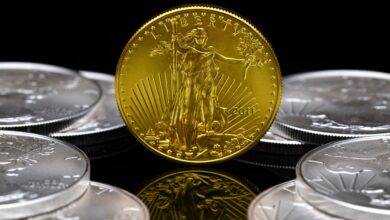How Geopolitics Drives Gold Prices

There is conflict happening all around the globe. It seems that everyday tensions between large superpowers continue to heat up. Geopolitics significantly impacts gold prices due to the metal’s status as a safe-haven asset. That’s why it’s important for precious metal investors to pay attention to geopolitical events. Particularly given the uncertainties and risks it can create in the global markets.
These growing conflicts between countries are prompting investors to move toward gold as a safe-haven asset. As a result, this increased demand generally drives up gold prices. The extent of the impact depends on several factors. These include the severity and scale of the geopolitical event and its perceived effect on global economic stability.

Geopolitical tensions are a major driver for gold prices.
Let’s examine the various ways in which geopolitics impacts the price of gold.
Political Instability
Political instability leads to volatility in financial markets. This happens as investors react to uncertain political climates. During periods of instability, investors often seek to reduce exposure to riskier assets, such as stocks and bonds. They instead move their investments into safer assets like gold. This shift in investment strategy increases demand for gold, thereby driving up its price.
Gold is traditionally viewed as a safe-haven asset. It retains value or even appreciates during times of turmoil. When political situations become unstable, investors flock to gold. The idea is to protect their wealth from potential declines in other asset classes. This happens during coups, protests, or government collapses.
Armed conflicts, such as wars in the Middle East, tend to increase uncertainty and risk in global markets. As a result, investors seek the safety of gold. For example, during the Gulf War in the early 1990s and the Iraq War in 2003, gold prices rose as investors sought stability.
Economic Sanctions
Economic sanctions create significant uncertainty in global markets. Investors may become concerned about the economic stability of the countries involved. The potential ripple effects on the global economy are also uncertain. This uncertainty prompts a flight to safety. Gold is a preferred safe-haven asset, thereby increasing its demand and price.
Sanctions can destabilize economies by restricting access to international markets. This may involve freezing assets and limiting financial transactions. Gold is considered a more secure investment during such turbulent times. Investors often respond to these risks by moving their capital into gold.
In particular, sanctions can disrupt supply chains, leading to shortages of goods and higher prices. This inflationary pressure makes gold more attractive as a hedge against inflation. Sanctions can lead to economic instability and reduced economic growth. That can result in higher inflation. Investors may turn to gold to protect their assets from the erosive effects of inflation.
Economic sanctions, like those imposed on countries such as Iran or Russia, can disrupt global trade and financial systems. This causes economic uncertainty that pushes investors toward gold. Trade tensions, especially between major economies like the U.S. and China, create volatility in global markets. For instance, the trade war between the U.S. and China in recent years contributed to rising gold prices. Investors looked for a hedge against potential economic fallout.
Trade Wars
Trade wars create uncertainty about future trade policies, tariffs, and international economic relations. This uncertainty can lead to volatility in stock markets and other asset classes. In turn, it prompts investors to seek the safety of gold, which increases its demand and price.
Moreover, competing trade blocs such as the BRICS countries may even turn to gold as a settlement currency in the event that global trade in U.S. dollars breaks down.
Prolonged trade wars can slow down global economic growth. They reduce trade volumes, increase production costs, and disrupt global supply chains. During such slowdowns, investors often turn to gold as a defensive investment, pushing up its price.
Currency Fluctuations
Geopolitical events that lead to the devaluation of major currencies, such as the U.S. dollar, often result in higher gold prices.
Gold is typically priced in U.S. dollars on international markets. When the value of the dollar rises, gold becomes more expensive for investors using other currencies. This can reduce demand and lower gold prices.
Conversely, when the dollar weakens, gold becomes cheaper for these investors. Investors often buy gold as a hedge against a declining dollar. When the dollar loses value, the real purchasing power of dollar-denominated assets decreases. By comparison gold historically retains value better in such scenarios.
Fluctuations in other major currencies, such as the euro, yen, or pound, also impact gold prices. For instance, if the euro weakens against the dollar, gold prices in euros might rise, spurring increased demand in Europe.
In countries with volatile currencies or high inflation rates, such as Argentina or Turkey, gold is often seen as a stable store of value. Fluctuations in these currencies can lead to increased local demand for gold, influencing global prices.
Monetary Policy
Central banks hold significant gold reserves. These institutions can influence gold prices through their buying and selling activities. If a central bank increases its gold reserves, it can signal confidence in gold as a store of value, driving up prices. Conversely, selling large amounts of gold can depress prices.
During times of geopolitical tension, central banks may increase their gold reserves. This diversifies their holdings away from fiat currencies, driving up gold demand. For example, Russia and China have increased their gold reserves in response to geopolitical tensions with the U.S. and Europe.
Central bank announcements and policy changes can impact investor expectations and behavior. For instance, dovish signals (indicating lower future interest rates or continued QE) can lead to higher gold prices. Hawkish signals (indicating higher future interest rates or tapering QE) can have the opposite effect.
There is generally an inverse relationship between interest rates and gold prices. When central banks raise interest rates, yields on bonds and savings accounts become more attractive. That reduces the appeal of non-yielding assets like gold. This can lead to a decrease in gold prices.
To the contrary, when interest rates fall, the opportunity cost of holding gold decreases, making it more attractive. Real interest rates (nominal rates minus inflation) are particularly important. Negative real rates, where inflation is higher than nominal rates, are especially bullish for gold prices. The opportunity cost of holding gold is lower in such environments.
Global Economic Policies and Agreements
Economic policy changes come in the form of tariffs or changes in trade policies. They can affect global economic stability and gold prices. For example, the uncertainty surrounding Brexit negotiations led to fluctuations in gold prices. Investors react to these types of evolving situations.

The global impact of economic policies has a significant effect on financial markets.
Major trade agreements can promote economic stability and growth. They do so by reducing trade barriers and fostering economic cooperation. Examples are the North American Free Trade Agreement (NAFTA) or the Trans-Pacific Partnership (TPP). Stability tends to reduce the demand for safe-haven assets like gold. Potentially this leads to lower gold prices.
Positive trade agreements can boost investor confidence in global economic prospects. This leads to a stronger performance in riskier assets like stocks, reducing the appeal of gold. But trade wars, such as the recent U.S.-China trade tensions, create uncertainty and volatility in financial markets. This uncertainty drives investors toward safe-haven assets like gold.
Drawn out trade disputes can slow down global economic growth by disrupting supply chains, increasing costs, and reducing trade volumes. In response to an economic slowdown, investors may turn to gold to protect their portfolios, pushing up its price.
Takeaway: Geopolitics Have a Major Impact on the Gold Price
Geopolitical issues include political instability, economic sanctions, and trade wars. Each significantly impacts gold prices by creating uncertainty and market volatility. These factors drive investors to seek the stability of gold as a safe-haven asset. Currency fluctuations and monetary policies, like interest rate changes and quantitative easing, also influence gold prices, with a weaker dollar generally boosting demand. Overall, during geopolitical turmoil, gold prices tend to rise due to its perceived stability and value retention.
Written by Paulina Likos
Read more about gold as an investment from the expert authors at Gainesville Coins:
Is Gold a Safe Investment Now? (June 2024)
How to Store Gold Safely: 7 Best Options for Gold Storage
Is Gold Liquid? Yes and Here’s Why
Why Dave Ramsey Is Wrong About Gold
5 Safe Investments During a Recession





